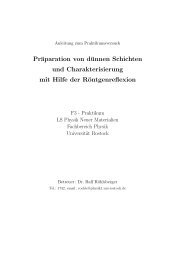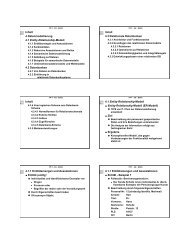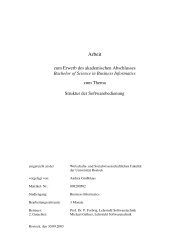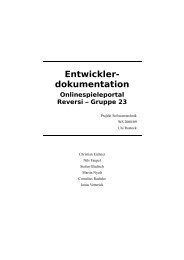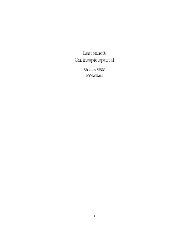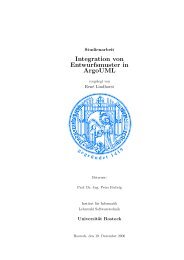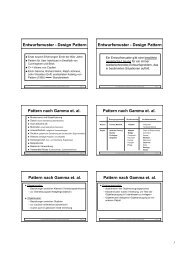paper - Universität Rostock
paper - Universität Rostock
paper - Universität Rostock
Create successful ePaper yourself
Turn your PDF publications into a flip-book with our unique Google optimized e-Paper software.
action model<br />
organizing<br />
examination<br />
actor: P, P(A)<br />
...<br />
marking<br />
...<br />
well-trained students<br />
...<br />
support/<br />
hinder<br />
Goal<br />
and<br />
goal<br />
model<br />
many students<br />
marking single<br />
exercises<br />
...<br />
Single list (SL)<br />
exerc.nr: Int<br />
max.points: Int<br />
students:Ρ(Ex_Entry)<br />
Ex_Entry<br />
name: String<br />
points: Int<br />
compiling the<br />
total list<br />
↓↑: Ρ(SL), C ↑:TL<br />
artifact/<br />
means<br />
Res_Entry<br />
name: String<br />
points: Int<br />
mark: {1..5}<br />
...<br />
Total list (TL)<br />
evaluating<br />
the results<br />
↓↑: TL …<br />
max.points: Int<br />
students:Ρ(Res_Entry)<br />
Criteria of marks (C)<br />
1: Int_range …<br />
5: Int_range<br />
rechecking the<br />
total list<br />
business<br />
object<br />
model<br />
actor<br />
Assistant (A)<br />
…<br />
Student (S)<br />
Prof (P)<br />
…<br />
user<br />
model<br />
Figure 1: The sub-models of an example task model<br />
A goal cannot be fulfilled without performing some appropriate actions changing the state of the<br />
domain. In order to emphasize the central role of actions only the relationships between the action<br />
model and the other ones are sketched out in the example of Fig.1 which partly explores the task<br />
of educating students. Every sub-action supports or hinders some sub-goals. Thus, the action<br />
hierarchy reflects the compromises made in planning the achievement of the goal.<br />
Executing an action means to create, destroy, use, or change some business objects. In other<br />
words, an action needs a set of objects in a certain state (precondition) and supplies a set of objects<br />
in a certain state (post condition or effect). Actions at a higher level of the hierarchy and, finally,<br />
the goals represent approximations of or views on affected business objects and their states. For<br />
example, the effect of compiling the total list in Fig.1 is the object Total list (abbrev. TL, ↓/↑ mark<br />
pre-/post conditions). With respect to an action a business object can play the role of an artefact or<br />
a means of work. Means are applied to change the state of the artefact which is essential for the<br />
achievement of the goal. They are further divided into tools used and resources consumed in<br />
actions. The artefact of compiling the total list is Total list, a set of Single lists and the object<br />
Criteria of marks are used as tools.<br />
A task can demand the participation of a whole group of people. In this <strong>paper</strong>, the division of<br />
labour is simply modelled by assigning actors to the nodes of an action hierarchy. Consequently, it<br />
is reasonable not to stop the action decomposition until the basic actions (the leaf nodes) are<br />
executed by single persons. Otherwise, questions concerning the division of labour are still open.<br />
In Fig.1, Prof. and (set of) Assistant(s) are the actors in organizing examination. Task models are<br />
described e.g. in [Dit02] more formal and detailed.



